 TRIZ/USIT Paper TRIZ/USIT Paper |

 
|
Establishing general methodologies of
creative problem-solving / task-achieving:
Beyond TRIZ
|
| Toru Nakagawa (Osaka Gakuin University),
Presented at ETRIA TRIZ Future Conference 2012
Held by European TRIZ Association (ETRIA) on Oct. 24-26, 2012 in Lisbon, Portugal
|
| [Posted on Dec. 5, 2012] |
For going back to Japanese pages, press  buttons.
buttons.
Editor's Note (Toru Nakagawa, Dec. 2, 2012)
This page shows the paper I presented at ETRIA TFC 2012 in Lisbon. The presentation was based on a series of works started in May 2012 as described in the Research Notes  . Basic and full description was made in May as a document for discussing the future directions of TRIZ in Japan (posted in the Japanese page
. Basic and full description was made in May as a document for discussing the future directions of TRIZ in Japan (posted in the Japanese page  ). Then the research has been extended and recorded in three relevant presentations/papers: i.e., presentation at Japan TRIZ Symposium
). Then the research has been extended and recorded in three relevant presentations/papers: i.e., presentation at Japan TRIZ Symposium 
 , presentation & paper at ETRIA TFC2012
, presentation & paper at ETRIA TFC2012  , and a paper published in "TRIZ Home Page in Japan" in Japanese
, and a paper published in "TRIZ Home Page in Japan" in Japanese  .
.
The present paper was submitted late in August. On sending my manuscript of full paper to TFC, Dr. Tom Vaneker, Twente University, the Netherlands, kindly gave me detailed advices to brush up my English expressions; so I sent the revised version on October 10. In the Proceedings of ETRIA TFC 2012, my earlier version was printed due to the late arrival of my revised one. In the present page, I am posting my full paper in its final revised version. I deeply thank Dr. Vaneker for his kind advices.
This page contains: Full paper in HTML and in PDF  (12 pages, 614 KB), Presentation slides in HTML and in PDF
(12 pages, 614 KB), Presentation slides in HTML and in PDF  (18 slides, 155 KB).
(18 slides, 155 KB).
Contents of the Full Paper:
Abstract
1. Introduction
2. Model (a) for a person to learn and master TRIZ
3. Model (b) of activities for an engineer and a company to learn and master TRIZ
4. Model (c) of overall activities of TRIZ promoters in Japan
5. Model (d) of areas for TRIZ application
6. Model (e) of activities for achieving the new general target
7. Model (f) of 'Creative problem-solving / task-achieving methodology' we should pursue.
8. Concluding remarks
References
 Full Paper
Full Paper
Establishing general methodologies of
creative problem-solving / task-achieving: Beyond TRIZ
Toru Nakagawa (Osaka Gakuin University)
ETRIA TRIZ Future Conference 2012
on Oct. 24-26, 2012 in Lisbon, Portugal
Abstract
The research presented in this paper was motivated by the detection of a problem (especially in Japan): "Why is the use of a creative problem solving method, TRIZ, not practiced more among (especially younger) people? What should we do?". This problem is not technological, where TRIZ has its strengths, but it is a quite common type of problem in a non-technological area where the problem situations are vague and complex and hence TRIZ seems not have enough power.
The problem was investigated on the basis of personal experience and views. The approach adopted in the present study is to describe the problem situations in models viewed from different perspectives step by step, using informal diagrammatic representations. They include:
(a) a model for a person to learn and master TRIZ,
(b) a model for an engineer and a company to learn and master TRIZ,
(c) a model describing the overall activities of TRIZ promoters within Japan,
(d) a model of areas where the application of TRIZ is expected and desirable.
These models guided me to notice that what is really needed to learn and apply is not TRIZ itself but something more general and commonly applicable. Thus a new general target was defined: "To establish a methodology of creative problem-solving / task-achieving, to spread it widely, and to apply it to problem-solving / task-achieving jobs in various domains in the whole country (and the world)".
After this insight some more models were described supporting this new target. They include:
(e) a model describing activities needed for achieving this new target.
(f) a model describing the characteristics of the new 'creative problem-solving
/ task-achieving method', in technological and non-technological areas.
In the above models (a) to (f), apparently no TRIZ tools are used, but the systemic thinking in TRIZ has guided the model description. The views used in building models (a) to (f) were set along the process of understanding the current problem situations, understanding the ideal situation, obtaining ideas for a new system, and constructing conceptual solutions. Such a process is typical in the general scheme of creative problem solving, as described in Model (f). Thus the present study may be regarded as a case study of problem solving in non-technological area, by using the generalized method proposed here in place of TRIZ.
Further discussions on the models, especially on the new target, are desired and expected.
Keywords: TRIZ penetration; modeling; new target; general problem-solving methodology
1. Introduction
Since 1996 TRIZ has been successfully introduced into Japan. As a result of this introduction
• Industries got interested in TRIZ software tools and worked together to make their Japanese versions.
• Several TRIZ textbooks were translated into Japanese.
• TRIZ has been taught in several universities.
• The Japan TRIZ Society (initiated in 2005 and formally established in 2007) was organized by users and promoters of TRIZ as the national center for promoting TRIZ. It has held Japan TRIZ Symposium every year as a (partly) international conference, where about 40 papers have been presented every year by industrial users, consultants, and academic people.
• "TRIZ Home Page in Japan" has been operated actively since 1998 for spreading TRIZ information in Japan and in the world.
All these activities are still being executed with success. However, one big concern for the TRIZ leaders in Japan is related to the fact that many of Japanese TRIZ leaders are currently around 65 years old. They belong to the 'baby-boom generation', who worked hard in their younger years to support the rapid growth of the Japanese economy, and they encountered TRIZ when they were around 50. Having backgrounds within R&D methodologies, creative thinking, and TQC, etc., they formed the core members of the TRIZ community for these last 15 years. Since they have retired from industry or are almost at that point, the need is clear for younger people to take over the responsibility of promoting TRIZ.
But the dissemination of TRIZ into the younger generation has not been sufficient in Japan. What can be done to increase the acceptance and application of TRIZ among the younger generation? This shortly is the motivation of the study presented in this paper. Though we are confident in the effectiveness of TRIZ in technological problem solving, the present problem, slow dissemination of TRIZ among younger people, is not a technological problem. It is related to humans, organizations, and society. TRIZ in its original form does not have any suitable methods for these types of problems.
I have decided to study the problem, using all my capability and disregarding whether the akpplied method is TRIZ-based or not. My approach is to build models of the problem situation, representing in informal diagrams and viewing from different aspects step by step. The viewpoints are chosen to reveal the problem situations from different angles; i.e., from the persons and companies who are trying to accept TRIZ, from the organizations working for promoting TRIZ, and from the areas and issues to which the applications of TRIZ are desirable. These models guided me to a new target, i.e., establishing general methodologies for problem solving. Thus I further derived the models of needed activities and contents of the new target methodology. The models were built based on my personal observations, and were shown to the TRIZ leaders within Japan for discussion. The models should be more or less complete to allow for a macro understanding of the problem and also for defining solution directions. The modeling need to be extended further to reveal micro situations of problems and to find their solution directions.
2. Model (a) for a person to learn and master TRIZ
The first model describes learning tasks and challenges encountered by young people who encounter TRIZ and who also want to become an expert TRIZ user (capable to apply some TRIZ tools to real problems, or understand the structure of TRIZ and TRIZ thinking, etc.).
When looking at all the learning tasks that a young man/woman encounters, it becomes clear that from the viewpoint of this youngster learning TRIZ is just one of their many learning tasks. From birth they have to start to interact, love, walk, talk etc. When going to school writing, reading, arithmetic, geography, history are added. Also during high school, university and when starting as an engineer new learning opportunities are presented constantly (not only factual knowledge but also how to think, decide, and make actions). For the young people TRIZ is just one of many learning opportunities they encounter growing up. Another important viewpoint is that just encountering TRIZ (listening to TRIZ classes) is not enough to understand TRIZ at the level of successful application in later life stages.
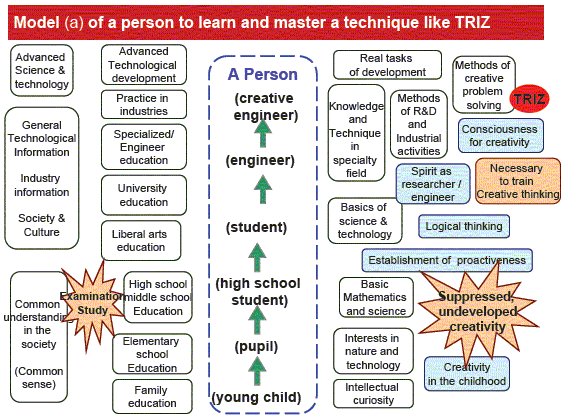
Fig. 1. Model (a) for a person to learn and master TRIZ
On the basis these views on learning TRIZ, we built Model (a) (Fig. 1), of learning aspects encountered by a person wanting to learn and master a technique like TRIZ. In the middle column of the figure life stages of a person are shown.. The left side of the figure shows the general education phases they go through, as well as the different stages of understanding science and technology.
The right side of the model represents the intellectual development needed for a person to understand TRIZ. Intellectual curiosity at the childhood grows into interests in nature and technology, and is backed up by learning basic mathematics and science. In later years the personal development is further improved by acquiring skills in specialized fields and by real jobs of development, etc.
At the utmost right the intellectual items related to creative thinking and TRIZ are depicted. As pointed out by Kenichi Yumino [2], the current school educational system suppresses curiosity and leaves creativity undeveloped (especially in Japan). School education puts much stress on 'learning', where students are requested to understand the 'correct knowledge' in the textbooks, to remember it and to apply it to sample problems. 'Creating' (new ideas and experimental trials) is suppressed because it is thought disturbing and time-wasting in the classes. This is a major drawback for students to become creative in their grown-up stages. To overcome these shortcoming of the early educational years, establishing proactiveness among students during their freshmen years is essential . Let the students think and act for him/herself under his/her own responsibility. Let the students, who are often hesitating, express and defend their ideas/opinions in class, in the reports, etc.
When studying the basics of science and technology the ability to think logically also develops further. Upon finalizing their study and during the first years as a professional engineer, professional engineering skills need to developed; a mindset to search for the truth, to think logically and honestly, and a mindset to create. At this stage, it is necessary to have the opportunities of receiving training in creative thinking. Finally while working as engineers, the young people learn and master methods of R&D and industrial activities. During this stage and if the consciousness of creativity is enhanced, methods of creative problem solving like TRIZ will have a good foundation to be learned and mastered.
To summarize; model (a) displays the necessary steps in the mental development of a person to learn and master TRIZ. If some parts of these mental activities are weak, the opportunities for the person to get interested in, learn and master TRIZ will be low. Thus it may be a basic approach, before training TRIZ itself, to encourage proactiveness and spirit as independent researcher.
3. Model (b) of activities for an engineer and a company to learn and master TRIZ
After model (a) another series of models have been built to describe the ways a company can adopt TRIZ. In Japan, bottom up (or more often middle down and middle up) penetration is typical, in contrast to Korean style top-down penetration of TRIZ in companies.
Such a series of models were combined to form model (b), shown in Fig. 2. The model combines three aspects: (1) activities in an industry needed to widely accept and finally apply TRIZ in the organization, (2) personal study and growth needed to become a TRIZ practitioner and leader, and finally (3) external information necessary to be available for (1) and (2).
Necessary activities in an industry are illustrated in the right part of Fig. 2. When there are many engineers within a company working in various fields of technology, some of them start learning about TRIZ with the help of external TRIZ information (shown in the left part of the figure). Some of them gradually will become TRIZ pioneers in the company. They may open an intranet TRIZ website, or invite an outside expert for an in-company TRIZ seminar. They also make trials of applying TRIZ to some practice projects. In some cases external TRIZ consultants may get involved in the TRIZ training and in the application to real projects. Through these applications, TRIZ practitioners emerge within the company. For the purpose of information exchange and cooperation an in-company TRIZ study group may be formed, leading to further penetration of TRIZ within the company. If the success cases become known in the company, in-company TRIZ symposium can be organized. Meanwhile some organization for TRIZ promotion may be formed officially within the company, and organizational TRIZ leaders will lead the promotion and application of TRIZ. These development steps for organizational activities and TRIZ leaders may be typical in (Japanese) industries. The speed and width of TRIZ promotion in the company depends on the level of managers who get actively involved in the TRIZ promotion.
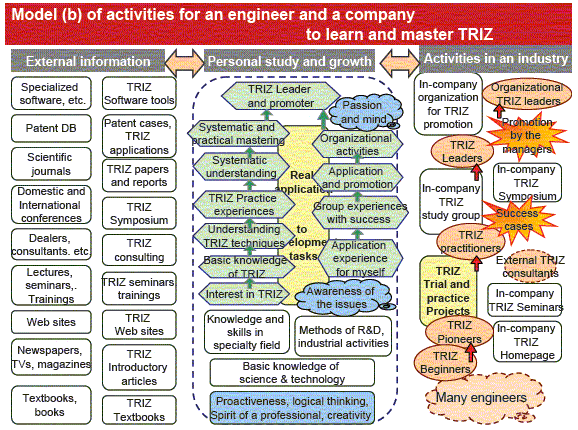
Fig. 2. Model (b) of activities for an engineer and a company to learn and master TRIZ
In the central part of Fig. 2, a model of personal study and growth in TRIZ is illustrated. The person who can become a TRIZ leader & promoter need to have the appropriate bases (as shown in the bottom 4 boxes, as discussed in Model (a)). Then the person need to have the awareness of the issue, i.e., the need to improve problem solving skills on the basis of some systematic and scientific methods. He/she gets interested in TRIZ and start learning basic TRIZ knowledge. This may be initiated by influences from either inside or outside the company (or both). He/she then goes ahead to understand TRIZ techniques and will have chances to apply his knowledge in a practice project or in a real project guided by some other TRIZ practitioners. Such experiences encourage him/her further to understand TRIZ systematically and he/she will try to apply TRIZ to many more real projects. In this stage, he/she will be recognized in the company as one of the TRIZ practitioners and will have a chance of becoming a TRIZ leader/promoter at his/her own division or at company scale. If he/she has enough passion and mind, he/she will become a TRIZ leader & promoter. To reach this level he/she should have mastered TRIZ in systematic and practical manner and have experience with organizational activities. It is important for a company to educate and encourage their engineers/managers to go through these steps and to make sure that there are sufficient engineers/managers at each level/step.
For supporting the company activities and the personal study and growth of the TRIZ leaders, external (out of the company, and often public) information is useful and need to be available. As shown in the left-most column of Fig. 2, there are various types of general media, tools, and services that may cover much wider areas than TRIZ. In the next column different types of external information dedicated to TRIZ are shown. TRIZ textbooks, introductory articles, and websites are useful for many new TRIZ learners. External TRIZ seminars and trainings are useful for TRIZ learners at some study level, while TRIZ consulting may be effective for a company to introduce in an early stage of TRIZ promotion. TRIZ conferences, e.g. Japan TRIZ Symposia, are useful to listen to different real approaches of TRIZ, to understand new trends in TRIZ, to establish personal communication networks, and to present your own work and open it up for discussion. TRIZ software tools, having accesses to patent databases, and to Effects knowledge bases, etc. are powerful information sources that can be used by TRIZ practitioners in a company. All the external information are useful and effective in different stages and for different types of users. It is important for the TRIZ community to provide them readily as reliable information.
4. Model (c) of overall activities of TRIZ promoters in Japan
Next we tried to examine the activities of different TRIZ promoters in Japan. we have chosen the following TRIZ promoters:
1. (former) Mitsubishi Research Institute's Knowledge Creation Department, who worked in contract with Invention Machine Inc. and organized a large group of industrial users
2. SANNO Institute of Management, who executed TRIZ consulting for industries (in cooperation with Ideation International Inc).
3. Nikkei BP, who introduced and promoted TRIZ actively during 1996-2003,
4. The TRIZ study group inside Japan VE Society Kansai Branch, which has been running monthly discussion and workshop meetings. The group consists of voluntary members from about 20 different companies,
5. (former) Professor Youtaro Hatamura's group at The University of Tokyo, who introduced TRIZ at the early stage but on a stance rather critical to TRIZ,
6. Toru Nakagawa of Osaka Gakuin University, who promoted TRIZ mainly through his website "TRIZ Home Page in Japan",
7. IDEA Co., who is currently active as TRIZ consultants in TRIZ, and
8. The Japan TRIZ Society, as a national center for TRIZ promotion mainly through its annual Japan TRIZ Symposium.
For each TRIZ promoter their activities were listed in a modified version of Model (b); the promoter's activities are listed in the central part (replacing the personal study and growth section). It intends to position various promoter's activities on how they contribute to generate or deliver external TRIZ information, and how they contribute to TRIZ promotion in industries.
Skipping all these models of individual promoters, Model (c) in Fig. 3 will show overall activities of TRIZ promoters in Japan. As can be seen, various types of promoters are arranged around a central figure. They are: Japan TRIZ Society, "TRIZ Home Page in Japan", overseas TRIZ information, publishers & journalism, academia and conferences, universities, vendors & consultants, voluntary study groups, and user companies. In the central figure, the combined activities carried out by all these promoters are shown. They include TRIZ research, development of methods/software tools/knowledge bases, realistic cases of TRIZ application & promotion, etc. etc.
Not all activities are executed at the desired extent or quality. Also we know that some type of activities can be best carried out in cooperation by multiple types of these promoters. Model (c) serves as a basis for the discussion on how we best should promote TRIZ activities.
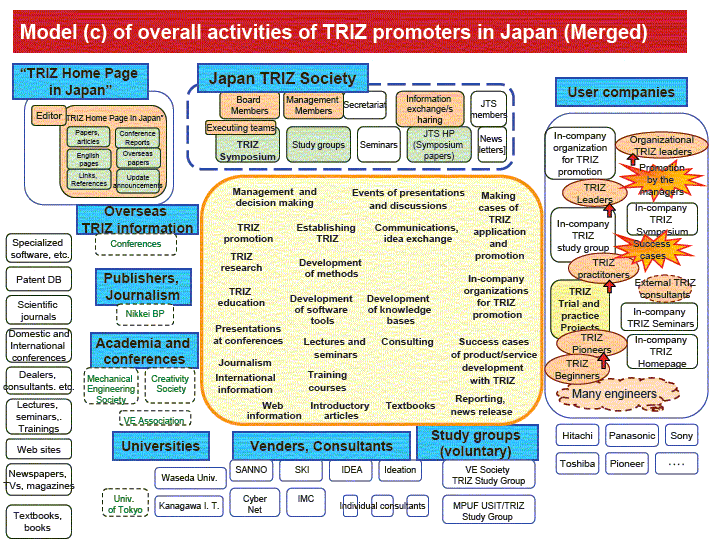
Fig. 3. Model (c) of overall activities of TRIZ promoters in Japan
5. Model (d) of areas for TRIZ application
Next various areas and issues where we want to apply TRIZ are considered. This resulted in Model (d), shown in Fig. 4. We put TRIZ at the center. To be able to be applicable in many fields TRIZ should have features like problem-solving/task-achieving methods, theory, creative thinking, easy understanding, benefits, solution results, practices, etc.
The main areas are characterized as: academia & universities, education, home, society, mass media & publishing, industries, and national & local policy. In each area, tasks to which TRIZ would be able to contribute and issues which TRIZ would be able to solve were considered and drawn in the figure. Encouraging original research, foundation of engineering education, creative thinking, etc. are expected in the area of academia & university. In the education area, changing from overweighing intellectual education to emphasizing creative thinking may be the most important issue. At home, creativity education to young children, and thus moving away from the learning for (university) entrance exams may be important. In society, TRIZ would enhance people's problem solving capability and flexibility in thinking and contribute to achieve various tasks in the society. Mass media & publishing are expected to spread knowledge and news of TRIZ in a wide range of society. In industries, TRIZ would contribute to problem-solving / task-achieving not only in manufacturing industries but also in agriculture, forestry, fishery, and service industries, etc. TRIZ would empower intellectual properties and vitalize industries. In the area of national & local policy, TRIZ would be useful to solve various problems and to achieve various tasks related to the national and local policy. Promotion of innovation and changing national education policy are also big issues where TRIZ can contribute.
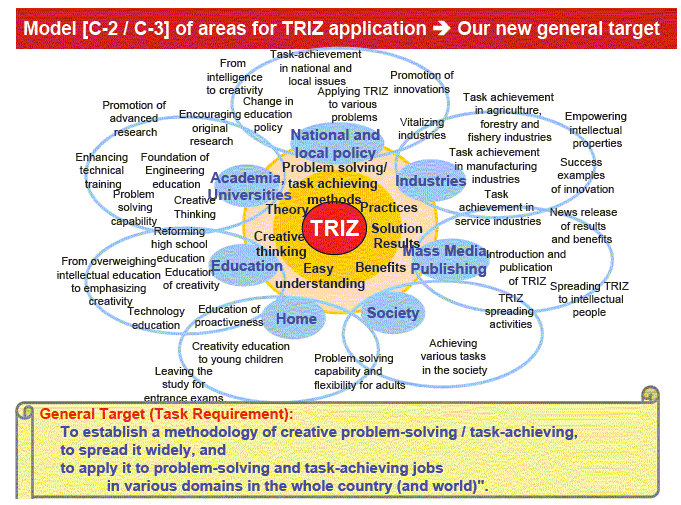
Fig. 4. Model (d) of areas for TRIZ application
Building this Model (d) has resulted in a big change in the understanding of the future of TRIZ. In this model, TRIZ was put at the center. It was natural at first because TRIZ (and some extended forms of it) was the main concern in the present study. However, the center of Model (d) should not be regarded as (a slight expansion of) TRIZ but as a general methodology for creative problem-solving and task-achieving. The latter should be more general and flexible and yet effectively applicable to wide range of issues as shown here. It may not be a single set of methods but a system of methods and methodologies containing many components.
On the basis of such a reasoning a new statement of our general target was obtained. I.e.,
• "To establish a methodology of creative problem-solving / task-achieving,
• To spread it widely, and
• To apply it to problem-solving and task-achieving jobs in various domains in the whole country (and the world)"
6. Model (e) of activities for achieving the new general target
Thus our next task was to clarify how we can achieve the new general target stated above in Model (d). For this purpose the ideas shown in previous models were used. It was found that Model (c) was useful as the basis of further consideration. Remodeling it Model (e) was obtained, as shown in Fig. 5. This shows the activities for achieving the first two items of our new general target, i.e., to establish a methodology of creative problem-solving / task-achieving, and to spread it widely.
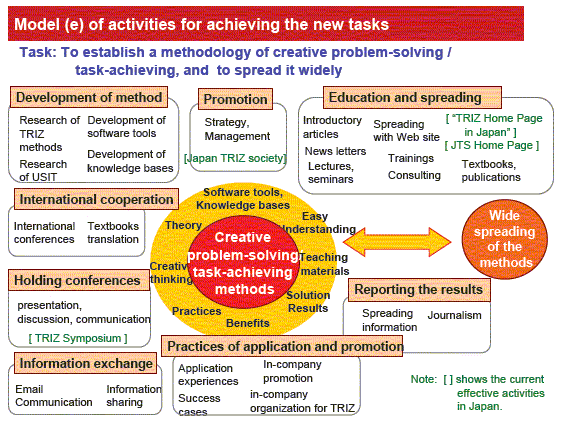
Fig. 5. Model (e) of activities for achieving the new general target
At the center of the Model (e) we put the new methods/methodology we want to develop in the near future. It should have some core features as shown in the circle: theory, creative thinking, practices, benefits, solution results, teaching materials, easy understanding, and software tools and knowledge bases, etc. For establishing such a general methodology, we need various types of activities, as for example the world TRIZ community has been doing so far. The actual development of the method may be the core activities, e.g., research of the TRIZ method (with much expansion), development of knowledge bases and software tools, etc. For enhancing the activities, international cooperation, holding conferences, and information exchange need to be activated. Also application and promotion in industries should be indispensible. Education and spreading the methodology are important for better understanding and also to make the methodology easy to understand. All such activities need to be promoted strategically. Establishing the methodology and wide spreading of it should work together in an attempt to enhance each other.
7. Model (f) of 'Creative problem-solving / task-achieving methodology' we should pursue.
Our next concern is the contents of our target methodology. In our new target statement, we mention 'methodology for creative problem-solving / task-achieving' and we now need to clarify what it should be.
The word 'problem solving' is used usually in a wide sense. In some cases it is regarded to start with the current negative situation, i.e., problem. But we also would like to include the approaches that seek for higher positive states even if the present situation is more or less satisfactory; i.e., task achieving. We may also include approaches that foresee the future and help us to think about positive or preventive actions.
We first built a model of such methodology in the technical area, where we have plenty of knowledge and experiences (based on TRIZ and some other methods). But this model is not shown here due to the limitation of the space.
Then we built Model (f), as shown in Fig. 6, of the general methodology of creative problem-solving / task-achieving in the non-technical areas, where humans, organizations, society and business are mainly involved. Even though TRIZ does not have much experiences and strengths yet in such areas, the framework of the methodology was derived rather smoothly by readjusting the TRIZ based model for technological areas.
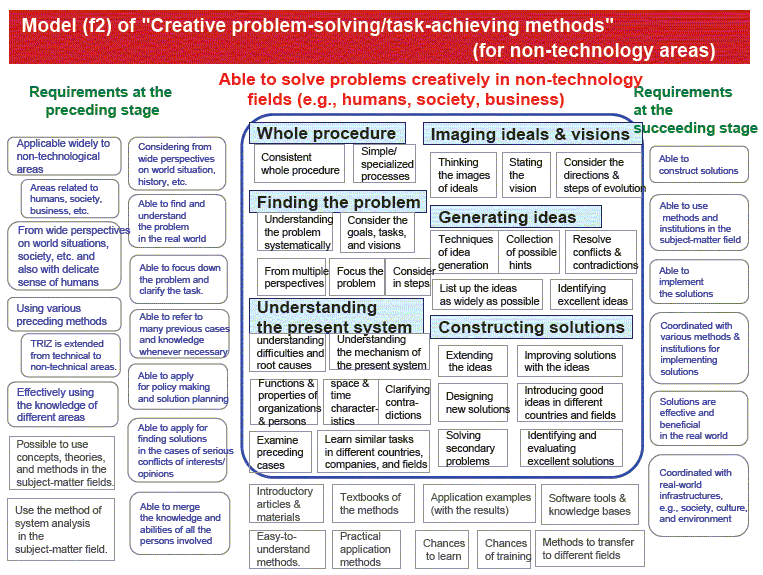
Fig. 6. Model (e) of creative problem-solving / task-achieving methods (for non-technology areas)
In the central part of Model (f) we show the main components of the methodology. We need to have (1) whole procedures, consistent and effective in wide variety of applications, and also simplified and specialized ones when needed for certain types of applications. These procedures typically should have the following features. (2) Finding the problem is the feature we need next. We need to understand the problem systematically and from multiple perspectives, we need to consider the goals, tasks, and visions at this early stage, and we need to focus the problem and to consider it step by step. (3) Understanding the present system is also a feature of our methodology. We need to understand the difficulties and root causes of the present situations and to understand the mechanism of the present system as much as possible. Functions and properties (of organizations and persons) and space and time characteristics of the problem are the keys to consider, and clarifying contradictions may be a good approach. We also need to examine preceding cases, and to learn similar tasks in different countries, companies, fields, etc. (4) Thinking about ideal situations and to develop visions on the future is another main feature of our general methodology. Based on them we can consider the directions for further development and steps of future evolution. Then, (5) generating ideas is another important feature. We need to have techniques for idea generation, where collections of possible hints may be useful, and we need to have methods to resolve conflicts and contradictions. We also need to have methods for organizing the ideas, for showing them in a hierarchical/systematic manner, and then to evaluate them in order to identify excellent and effective ideas. Finally, (6) constructing solutions is a main feature we need. We need to extend the ideas, to improve possible solutions with new ideas, and to design and construct new solutions. It is often useful to introduce good ideas and solutions found in different countries and fields, etc. We need to solve secondary problems in our new solutions. We need to identify and evaluate excellent solutions for real actions.
In Model (f), at the bottom of the central part we summarize the output of our methodology in the form of information materials. In the left part we show requirements at the preceding stage for applying our methodology, while in the right part, requirements at the succeeding stage. There is no space to describe them here, but in the future all these requirements will be recognized and grown to be satisfied step by step.
As a next step of model building, we have built a model of areas we want to apply our new methodology. It was a modification of Model (d), where individual issues are evaluated in its importance and in the possibility of our actions. But the model will not be shown in the present paper because it is not yet mature enough.
8. Concluding remarks
As stated above, the present study was motivated with the problem "Why does the creative problem solving method, TRIZ, not penetrate more smoothly among (especially younger) people? What should we do?" For tackling this problem, vague and complex in nature but yet a common type in non-technical fields, an approach was used of building a series of models from different perspectives.
Six models of them are shown here. Model (a) describes the intellectual and mental development of a person needed to accept TRIZ, while Model (b) represents the development of engineers and managers to become TRIZ practitioners & leaders along with the application and organizational activities of an industry; this is the crucial model for the penetration of TRIZ into industries. Next Model (c) describes the overall activities of TRIZ promoters within Japan. Then Model (d) describes the areas and issues where TRIZ application is desirable. At this stage, the present author has realized our new target to pursue. I.e., to establish a methodology of creative problem-solving, to spread it widely, and to apply it to problem-solving jobs in various domains in the whole country (and the world). For pursuing our new target, we have developed the models further. Model (e) describes the activities necessary for establishing the new methodology, while Model (f) demonstrates the expected contents of the new methodology applicable in general non-technological areas.
The process of building these models from different views corresponds to the process of problem solving expected in our new methodology: finding the problem, understanding the present system (Models (a)(b)(c)), imaging ideals & visions (Model (d)), generating ideas (new target in Model (d)), and constructing solutions (Models (e)(f)). (The present author has applied this process on the basis of the 'Six-box scheme' of USIT [3].) Thus the different views are set in sequence in accordance with the aims of phases of problem solving procedure, and the models may be regarded as the output documents of the phases. Hence each model guides us to a higher level of understanding of the problem from the viewpoint.
We used informal diagrams for representing the models. Diagrams are more suitable than sentences for representing structures among many components in a concise and comprehensive manner. Depending on the problems and views, we should better choose different ways of representing diagrams; thus we did not use any formal (having pre-defined logical rules) diagrams. The view in a model may not be simple; a few aspects may be combined for the purpose of understanding them together including their relationships.
In the present study all the models are described at a macro level. Description of models at a micro level is of course possible and suitable for discussing specific cases, for example how to teach TRIZ concepts in the 3rd year class of a chemical engineering department. Models at a micro level will guide you to specific solution concepts. Since we used models at a macro level, we have obtained our solution concept at a macro level. Actually we have obtained a solution concept of 'general methods of problem solving', which is a super-system of TRIZ.
We now need to discuss what is the merit of thinking/handling a super-system of TRIZ. 'To establish and penetrate general methods of problem solving' is of course a bigger and hence apparently farther-away task to achieve than 'to improve TRIZ and spread it widely'. Generally speaking, the merits of pursuing a target at a higher level are: (1) we know our purposes/aims at a higher level and hence we will be able to choose and evaluate solutions more correctly in the criteria of our purposes. (2) Different solutions at a lower level may conflict against and compete with one another, but at a higher level we may be able to unify them into a set of consistent and effective solutions. (3) Resources, including human power and information, can be used more efficiently at a higher level. Cooperation among people involved at a lower level may be powerful. etc. In the present case of the super-system of TRIZ, we can think of many situations where these general statements would well apply.
In the present study, the models were built on the basis of the author's personal views. They were shown to about 30 members of Japan TRIZ Society via email for discussion. Several of them have shown strong support, but most others gave me no responses. We will need further discussions on the implications of the present study at two levels: What should we do to penetrate TRIZ to younger people? and What is the general methods for problem solving, i.e. a super-system of TRIZ?
References
[1] Toru Nakagawa, Multiple Modeling to Set Up the Problems/Tasks: Establishing and Penetrating the Methodology of Creative Problem-Solving/Task-Achieving, 8th TRIZ Sympopsium in Japan, 2012, Held by Japan TRIZ Society, on Sept. 6-8, 2012 at Waseda Univ., Tokyo.
[2] Kenichi Yumino, Educating Creativity: Making the foundation for disseminating creation techniques, 8th TRIZ Sympopsium in Japan, 2012, Held by Japan TRIZ Society, on Sept. 6-8, 2012 at Waseda Univ., Tokyo.
[3] Toru Nakagawa, A New Paradigm for Creative Problem Solving: Six-Box Scheme in USIT, ETRIA "TRIZ Future 2006" Conference, on October 6 - 8, 2006 at Kortrijk, Belgium.
 Presentation Slides in English in PDF
Presentation Slides in English in PDF  (18 slides, 155 KB)
(18 slides, 155 KB)
 Presentation Slides in English
Presentation Slides in English
All the 18 slides are shown below to show the structure of the present work. For the details of some of the slides, please refer to the PDF pages  .
.
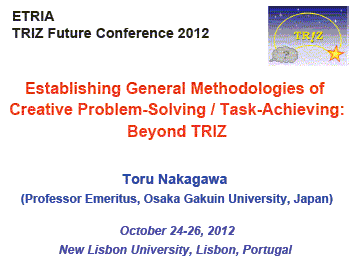
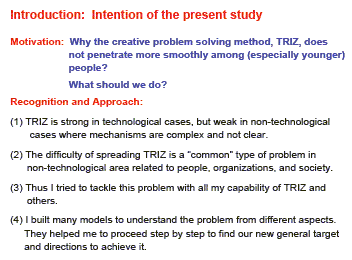
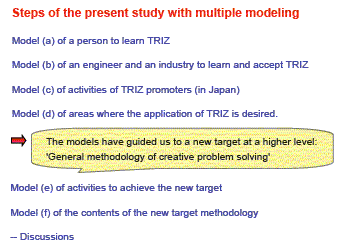
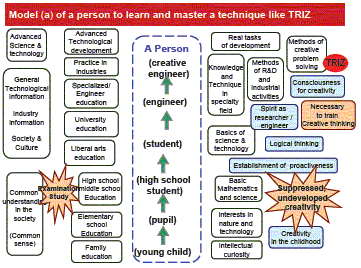
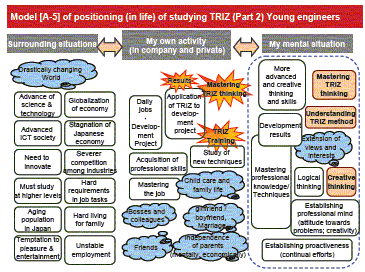
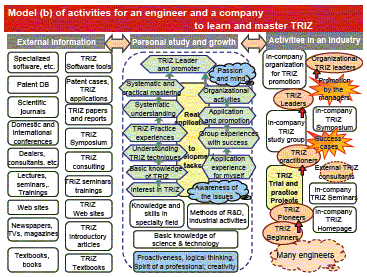
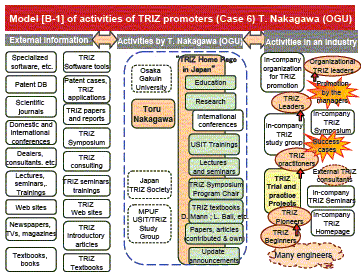
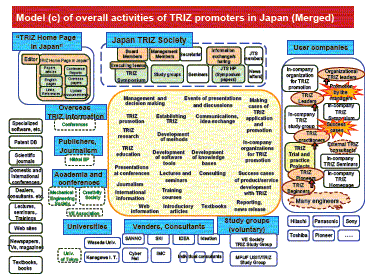
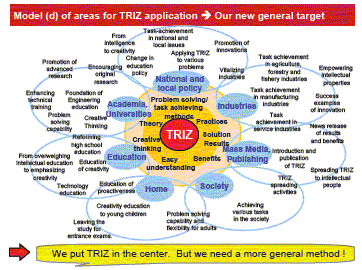
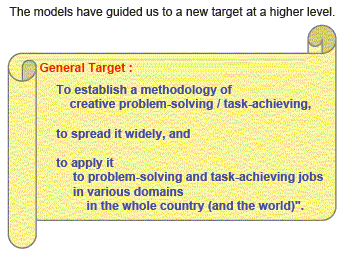
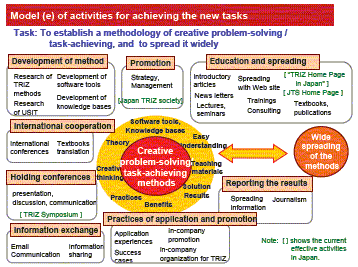
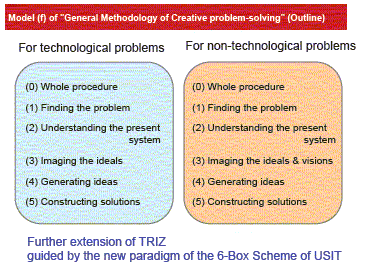
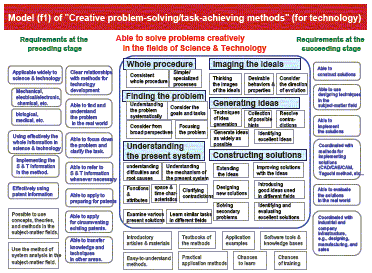
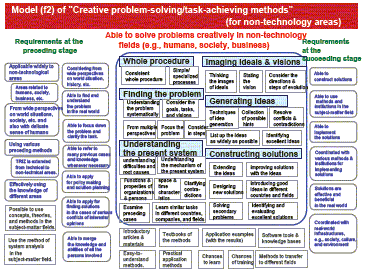
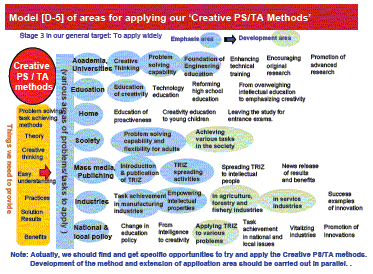
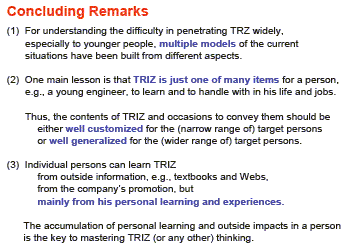
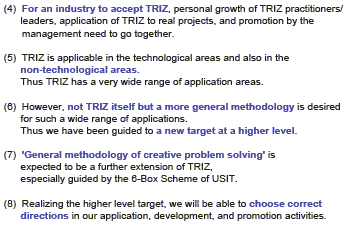
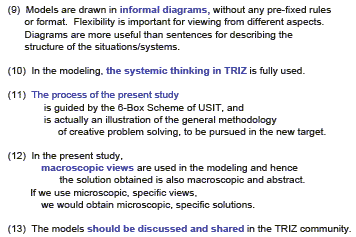
Last updated on Dec. 5, 2012. Access point: Editor: nakagawa@ogu.ac.jp























